Abstract
Trihydroxytetraenes, a novel series of oxygenated derivatives formed from arachidonic acid in human leukocytes, were recently isolated [Serhan, C. N., Hamberg, M. & Samuelsson, B. (1984) Biochem. Biophys. Res. Commun. 118, 943-949]. The structure of the major compound was established--i.e., 5,6,15L-trihydroxy-7,9,11,13-icosatetraenoic acid. The present study reports the structure of a second member of the trihydroxytetraene series of compounds--i.e., 5D,14,15L-trihydroxy-6,8,10,12-icosatetraenoic acid. When added to human neutrophils, 5,6,15L-trihydroxy-7,9,11,13-icosatetraenoic acid stimulated superoxide anion generation and degranulation at submicromolar concentrations without provoking a substantial aggregation response. With respect to superoxide anion generation, 5,6,15L-trihydroxy-7,9,11,13-icosatetraenoic acid proved to be as potent as leukotriene B4. In contrast, the compound was approximately 2 orders of magnitude less potent than either leukotriene B4 or fMet-Leu-Phe at provoking degranulation. The results indicate that interaction(s) between the 5- and 15-lipoxygenase pathways of human leukocytes leads to formation of a new series of oxygenated derivatives of arachidonic acid that may be involved in regulating specific cellular responses. The trivial names lipoxin A (5,6,15L-trihydroxy-7,9,11,13-icosatetraenoic acid) and lipoxin B (5D,14,15L-trihydroxy-6,8,10,12-icosatetraenoic acid) are proposed for the new compounds.
Full text
PDF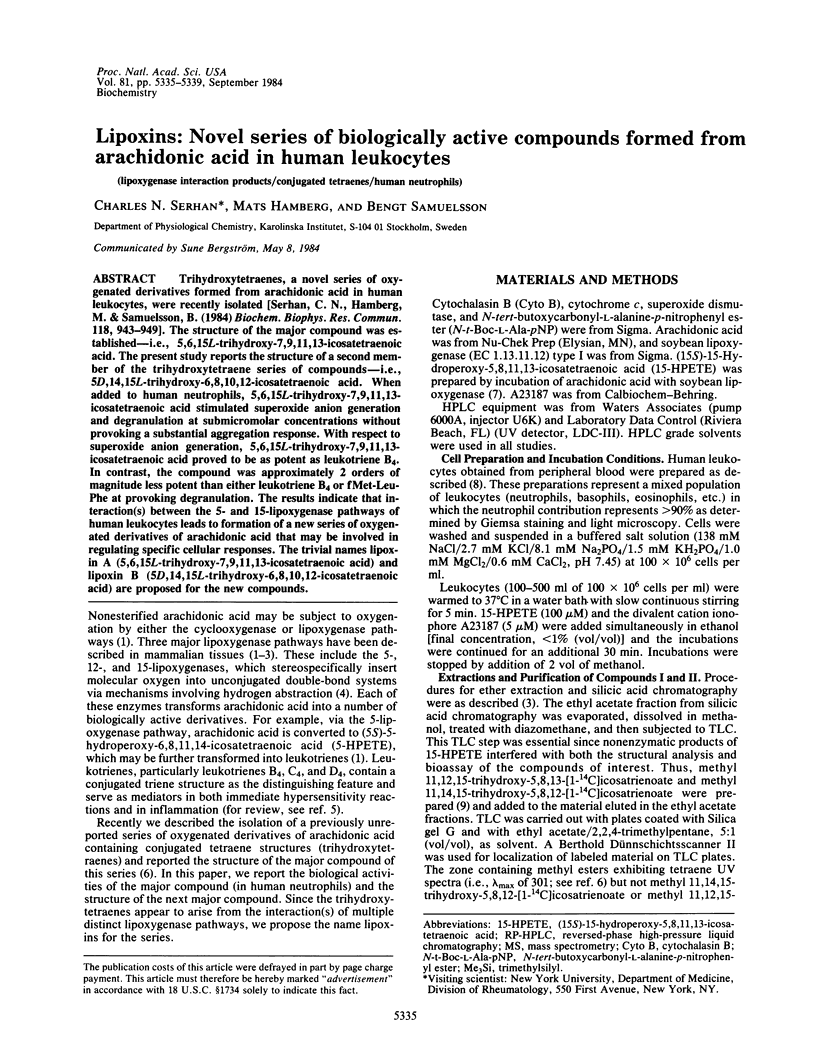
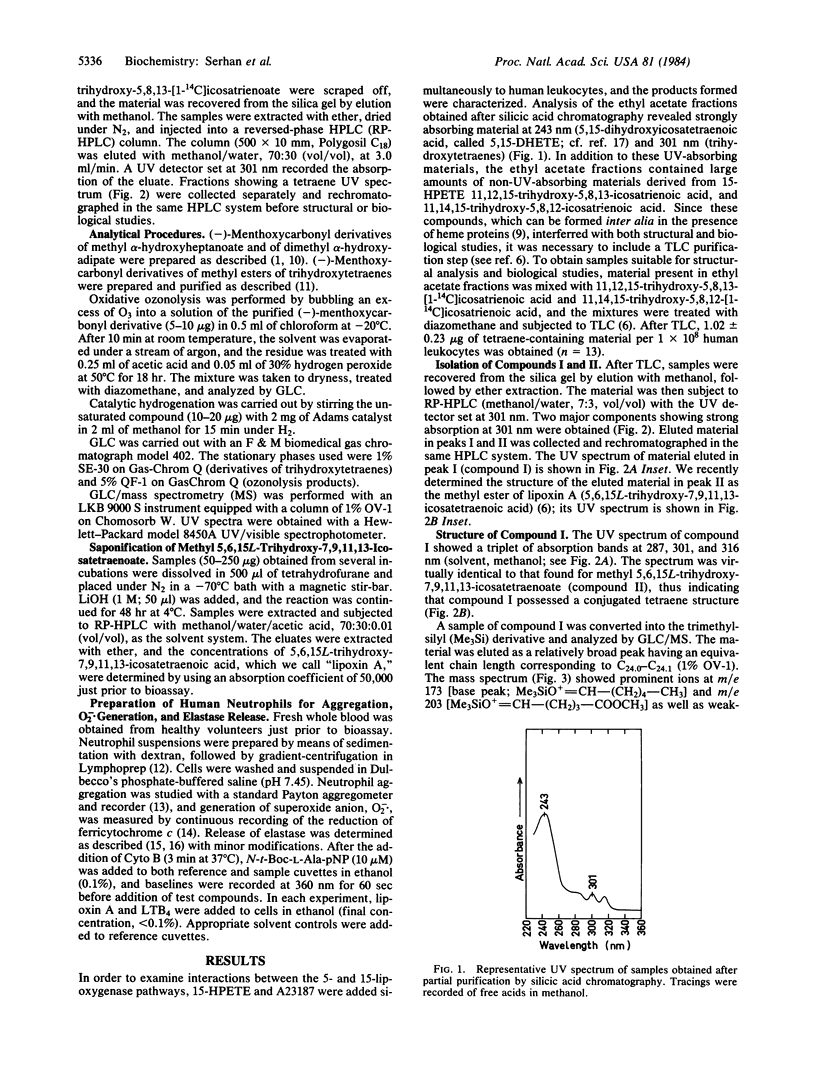
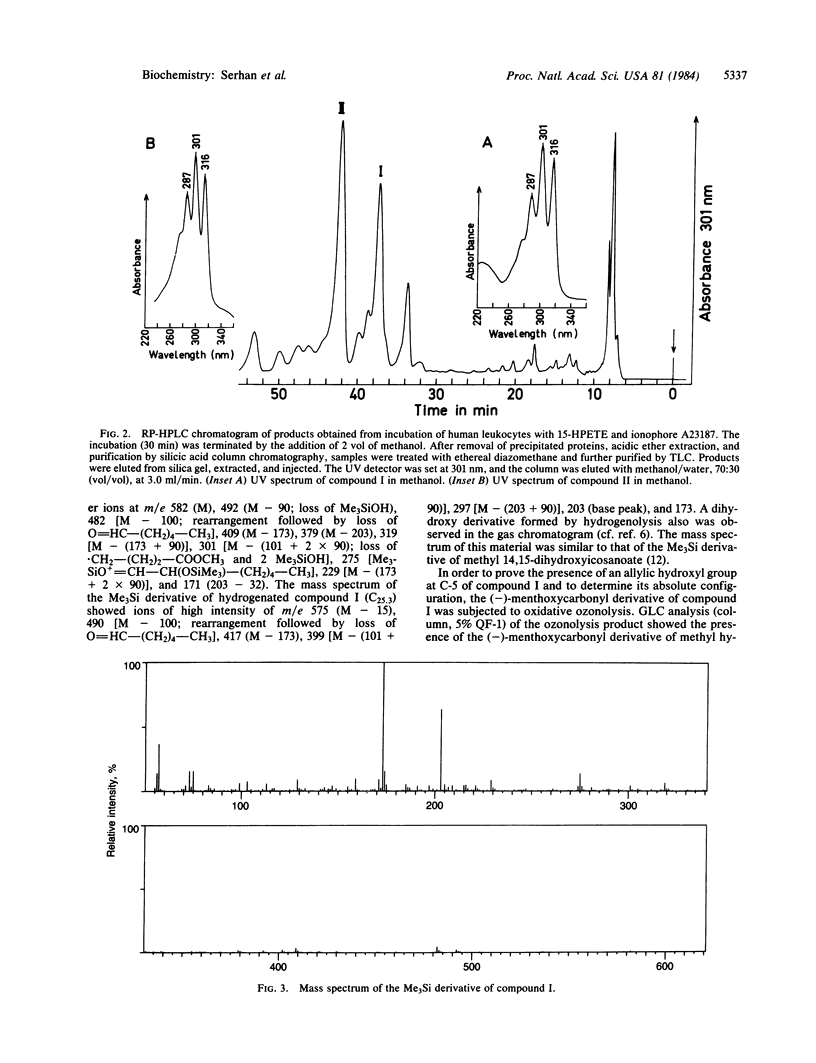
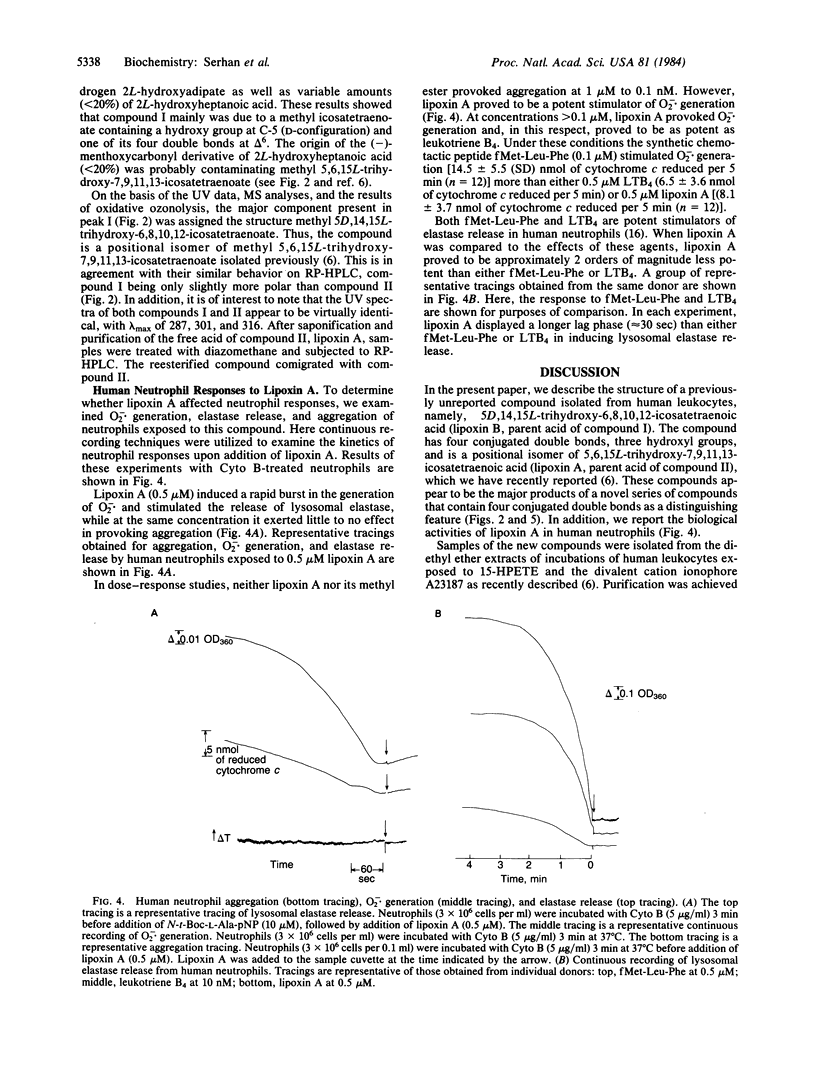
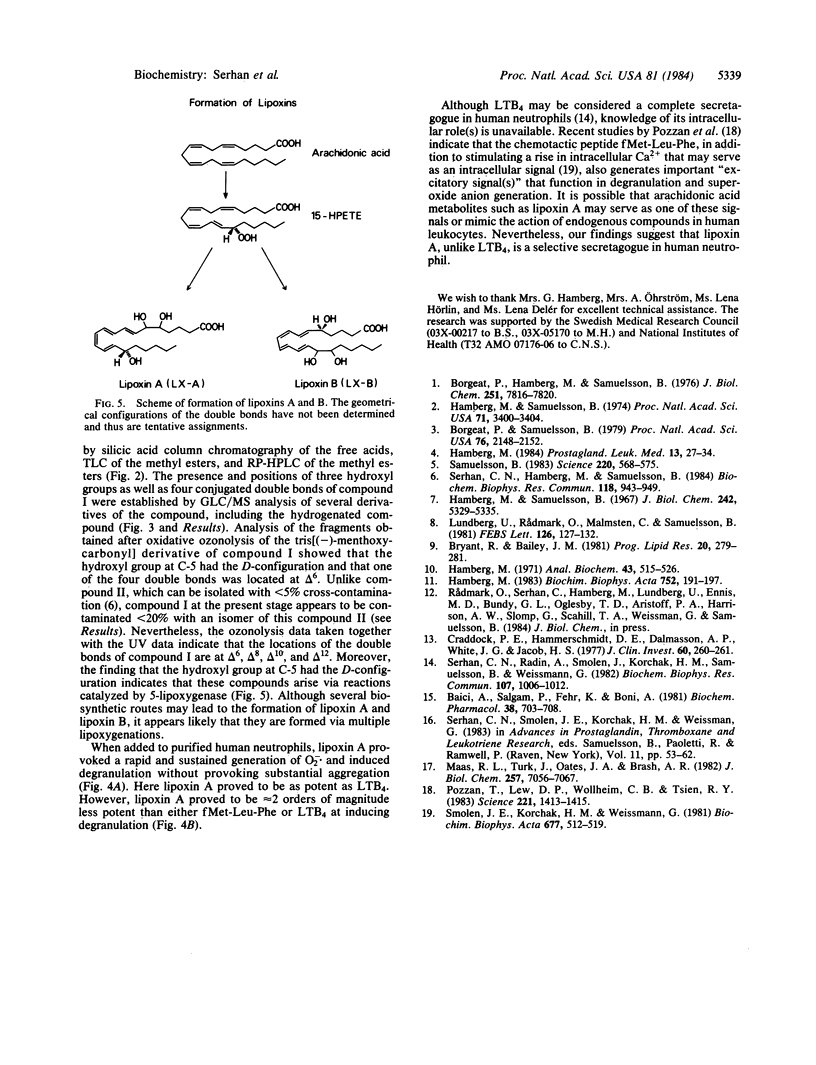
Selected References
These references are in PubMed. This may not be the complete list of references from this article.
- Baici A., Salgam P., Fehr K., Böni A. Inhibition of human elastase from polymorphonuclear leucocytes by gold sodium thiomalate and pentosan polysulfate (SP-54). Biochem Pharmacol. 1981 Apr 1;30(7):703–708. doi: 10.1016/0006-2952(81)90154-4. [DOI] [PubMed] [Google Scholar]
- Borgeat P., Hamberg M., Samuelsson B. Transformation of arachidonic acid and homo-gamma-linolenic acid by rabbit polymorphonuclear leukocytes. Monohydroxy acids from novel lipoxygenases. J Biol Chem. 1976 Dec 25;251(24):7816–7820. [PubMed] [Google Scholar]
- Borgeat P., Samuelsson B. Arachidonic acid metabolism in polymorphonuclear leukocytes: effects of ionophore A23187. Proc Natl Acad Sci U S A. 1979 May;76(5):2148–2152. doi: 10.1073/pnas.76.5.2148. [DOI] [PMC free article] [PubMed] [Google Scholar]
- Bryant R. W., Bailey J. M. Rearrangement of 15-hydroperoxy-eicosatetraenoic acid (15-HPETE) during incubations with hemoglobin: a model for platelet lipoxygenase metabolism. Prog Lipid Res. 1981;20:279–281. doi: 10.1016/0163-7827(81)90055-2. [DOI] [PubMed] [Google Scholar]
- Craddock P. R., Hammerschmidt D., White J. G., Dalmosso A. P., Jacob H. S. Complement (C5-a)-induced granulocyte aggregation in vitro. A possible mechanism of complement-mediated leukostasis and leukopenia. J Clin Invest. 1977 Jul;60(1):260–264. doi: 10.1172/JCI108763. [DOI] [PMC free article] [PubMed] [Google Scholar]
- Hamberg M. A novel transformation of 13-LS-hydroperoxy-9,11-octadecadienoic acid. Biochim Biophys Acta. 1983 Jul 12;752(2):191–197. doi: 10.1016/0005-2760(83)90112-1. [DOI] [PubMed] [Google Scholar]
- Hamberg M., Samuelsson B. On the specificity of the oxygenation of unsaturated fatty acids catalyzed by soybean lipoxidase. J Biol Chem. 1967 Nov 25;242(22):5329–5335. [PubMed] [Google Scholar]
- Hamberg M., Samuelsson B. Prostaglandin endoperoxides. Novel transformations of arachidonic acid in human platelets. Proc Natl Acad Sci U S A. 1974 Sep;71(9):3400–3404. doi: 10.1073/pnas.71.9.3400. [DOI] [PMC free article] [PubMed] [Google Scholar]
- Hamberg M. Steric analysis of hydroperoxides formed by lipoxygenase oxygenation of linoleic acid. Anal Biochem. 1971 Oct;43(2):515–526. doi: 10.1016/0003-2697(71)90282-x. [DOI] [PubMed] [Google Scholar]
- Lundberg U., Rådmark O., Malmsten C., Samuelsson B. Transformation of 15-hydroperoxy-5,9,11,13-eicosatetraenoic acid into novel leukotrienes. FEBS Lett. 1981 Apr 6;126(1):127–132. doi: 10.1016/0014-5793(81)81050-2. [DOI] [PubMed] [Google Scholar]
- Maas R. L., Turk J., Oates J. A., Brash A. R. Formation of a novel dihydroxy acid from arachidonic acid by lipoxygenase-catalyzed double oxygenation in rat mononuclear cells and human leukocytes. J Biol Chem. 1982 Jun 25;257(12):7056–7067. [PubMed] [Google Scholar]
- Pozzan T., Lew D. P., Wollheim C. B., Tsien R. Y. Is cytosolic ionized calcium regulating neutrophil activation? Science. 1983 Sep 30;221(4618):1413–1415. doi: 10.1126/science.6310757. [DOI] [PubMed] [Google Scholar]
- Samuelsson B. Leukotrienes: mediators of immediate hypersensitivity reactions and inflammation. Science. 1983 May 6;220(4597):568–575. doi: 10.1126/science.6301011. [DOI] [PubMed] [Google Scholar]
- Serhan C. N., Hamberg M., Samuelsson B. Trihydroxytetraenes: a novel series of compounds formed from arachidonic acid in human leukocytes. Biochem Biophys Res Commun. 1984 Feb 14;118(3):943–949. doi: 10.1016/0006-291x(84)91486-4. [DOI] [PubMed] [Google Scholar]
- Serhan C. N., Radin A., Smolen J. E., Korchak H., Samuelsson B., Weissmann G. Leukotriene B4 is a complete secretagogue in human neutrophils: a kinetic analysis. Biochem Biophys Res Commun. 1982 Aug;107(3):1006–1012. doi: 10.1016/0006-291x(82)90622-2. [DOI] [PubMed] [Google Scholar]
- Smolen J. E., Korchak H. M., Weissmann G. The roles of extracellular and intracellular calcium in lysosomal enzyme release and superoxide anion generation by human neutrophils. Biochim Biophys Acta. 1981 Nov 5;677(3-4):512–520. doi: 10.1016/0304-4165(81)90267-1. [DOI] [PubMed] [Google Scholar]


